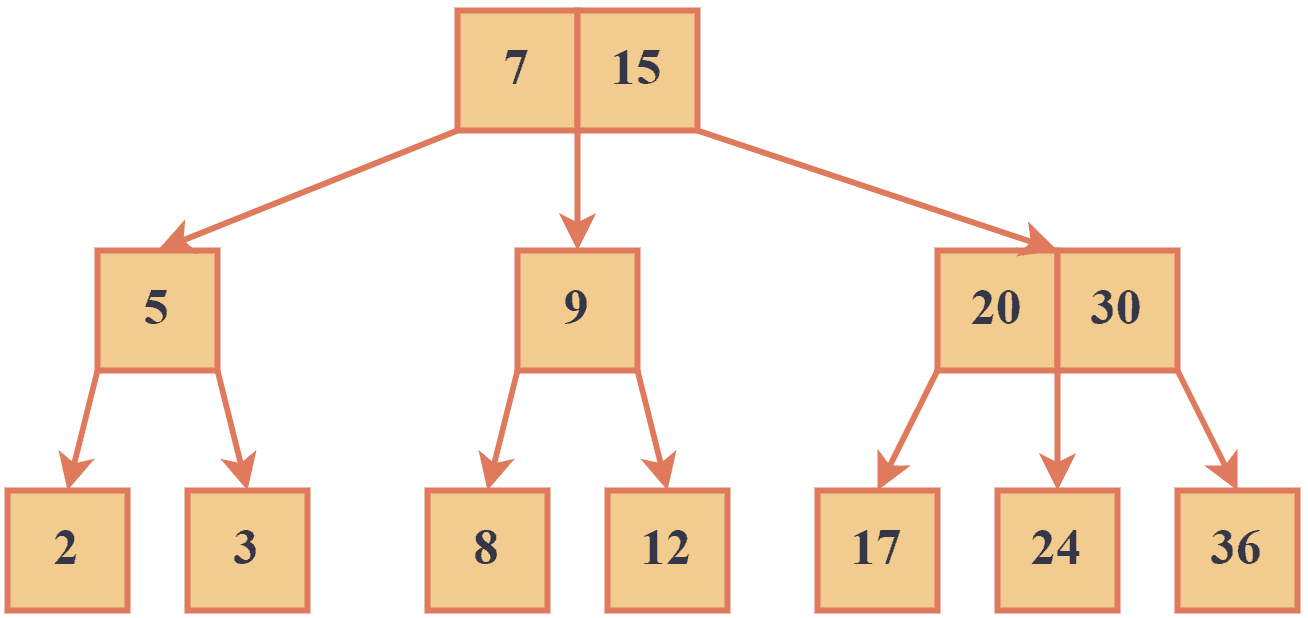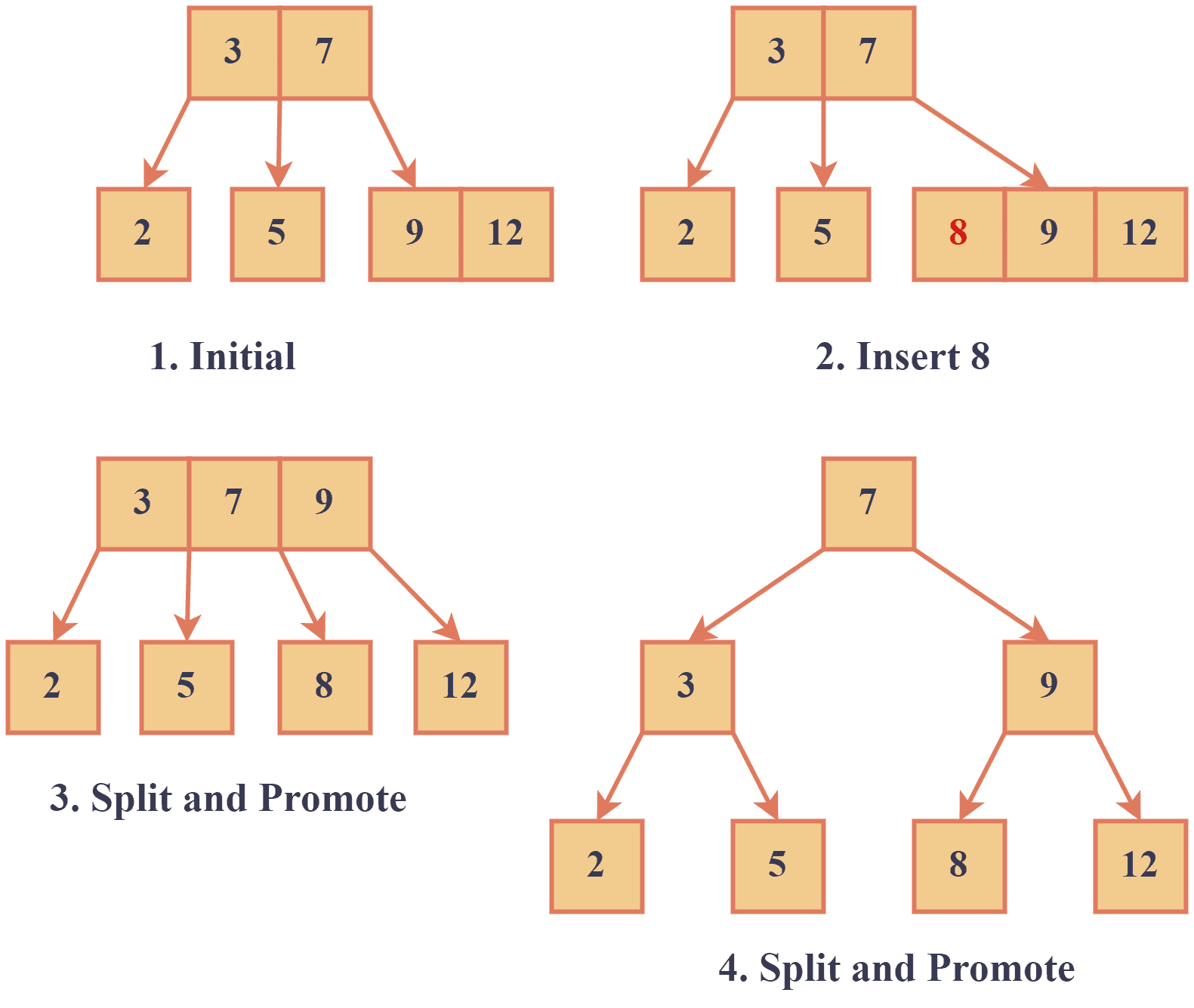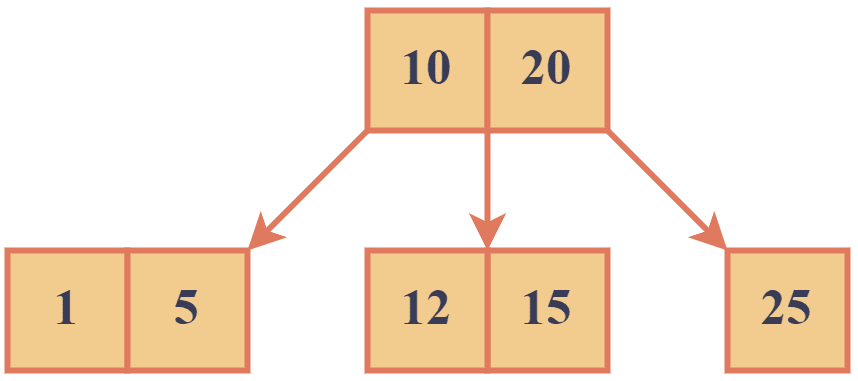1. Introduction
Multi-way search trees are a generalized version of binary trees that allow for efficient data searching and sorting. In contrast to binary search trees, which can only have two children per node, multi-way search trees can have multiple children per node.
In this tutorial, we’ll explore different types of multi-way search trees and common operations we can do with them.
2. Types of Multi-way Search Trees
There are several types of multi-way search trees, each with unique features and use cases. The two common types are 2-3 and B-tree.
2.1. 2-3 Tree
2-3 trees are multi-way search trees with two or three children per node.
The nodes in a 2-3 tree are sorted so that the smallest key is always in the leftmost child and the largest key is always in the rightmost child. They’re often used in applications that require moderate amounts of data, such as compilers and interpreters. Let’s look at an example of a 2-3 tree:

We can see that each node in the above example is either a 2-node or a 3-node.
2.2. B-Trees
B-trees have a variable number of children per node, typically ranging from 2 to hundreds.
Like 2-3 trees, B-trees are sorted so that keys are ordered from left to right. 2-3 trees are designed to optimize disk reads by ensuring that each node takes up a fixed amount of space on the disk. This allows for efficient storage and retrieval of large amounts of data and is commonly used in databases and file systems. Let’s look at an example of a B-tree:
3. Insertion
To insert a new key into a multi-way search tree, we start at the root node and traverse the tree until we find the appropriate leaf node. Once we reach the leaf node, we insert the new key into its correct position. If the node is already full or becomes full after the insertion, we split it into two nodes and insert the median key into the parent node. We repeat his process recursively until the entire tree is balanced.
3.1. Example
Let’s try to insert number 8 in this tree:
- Starting at the root node, we compare 8 to the keys in the node and determine that it should be inserted in the rightmost child.
- We insert 8 into it.
- We promote the middle key (9) to the parent node ([3 7]) to create a new parent node.
- We promote the middle key (7) to create a new parent node.
Now, the tree is balanced and satisfies the properties of a 2-3 tree.
The time complexity of insertion is time, where
is the number of nodes in the tree. This is due to the balanced structure of the tree, where each node has either 2 or 3 children. This ensures that the height of the tree is at most log base 2 of
.
3.2. Pseudocode
After understanding the concept and steps, let’s look at the pseudocode of the insert operation in a 2-3 Multi-way search tree:
algorithm Insertion23MultiwaySearchTree(T, k):
// INPUT
// T = pointer to the root of the 2-3 tree
// k = the key to be inserted
// OUTPUT
// Updated 2-3 tree T with k inserted
Find the appropriate leaf node N for key k by traversing the tree from the root
if N has less than 2 keys:
Insert k into N
else:
Split N into two nodes Left and Right with median key m
if k < m:
Insert k into Left
else:
Insert k into Right
if N is the root:
Create new root node R with m as its only key and children Left and Right
else:
Promote m to the parent node of N
Set Left and Right as children of the appropriate keys in the parent node
if the parent node is now full:
Recursively split the parent node
In this pseudocode, we find the leaf node to insert the key and split the node if it has more than two keys. If the parent node is full after insertion, we split it recursively to create new nodes.
4. Searching
To search for a key in a multi-way search tree, we start at the root node and compare the key to the keys in the current node:
- If the key matches one of the keys in the current node, we return the corresponding value.
- If the key is smaller than the smallest key in the current node, we move to the leftmost child.
- If the key is larger than the largest key in the current node, we move to the rightmost child.
- If the key is between the smallest and largest, we move to the middle child.
This process is repeated until the key is found or the appropriate leaf node is reached.
4.1. Example
For example, let’s try to find 11 in this tree:

We begin at the root node to search for the key 11 in the above example. Since 11 is between 10 and 20, we move to the middle child. The middle child node contains keys [12, 15], and since 11 is less than 12, we move to the left child of the middle node. The left child node contains no keys, so we have reached a leaf node, and the key 11 is not found in the tree.
The time complexity of search in a multi-way search tree is also in the average and worst cases. This is because the tree is balanced, and each node can have at most
children, reducing the search space by a factor of 3 at each level. Therefore, the search operation takes logarithmic time in the worst case.
4.2. Pseudocode
The general pseudocode for the search operation is given as follows:
algorithm SearchIn23Tree(T, k):
// INPUT
// T = a 2-3 multi-way search tree
// k = a key to search for
// OUTPUT
// The value associated with k if it exists in T, otherwise null
currentNode <- the root node of T
while currentNode is not a leaf node:
if k is equal to the first key in currentNode:
return the value associated with the first key
else if k is equal to the second key in currentNode:
return the value associated with the second key
else if k is less than the first key in currentNode:
currentNode <- left child of currentNode
else if k is greater than the second key in currentNode:
currentNode <- rightmost child of currentNode
else:
currentNode <- middle child of currentNode
if k is equal to the first key in currentNode:
return the value associated with the first key
else:
return null
In this pseudocode, we assume that the 2-3 search tree stores key-value pairs, and the search algorithm returns the value associated with the key if it is found in the tree; otherwise, it returns null.
5. Advantages of Multi-Way Search Trees
Multi-way search trees have several advantages over binary search trees, including.
Compared to binary search trees, they require fewer internal nodes to store items.
Due to their fixed height, balanced multi-way search trees can be efficiently stored on disk and accessed quickly.
Finally, multi-way search trees are generally easier to implement than other advanced data structures like AVL and red-black trees, which have stricter balancing requirements.
5. Conclusion
In this tutorial, we explored the multi-way search tree as a flexible and efficient data structure for storing and retrieving data. Multi-way search trees offer greater flexibility by allowing multiple children per node while maintaining a relatively low memory usage compared to binary search trees.
In addition, they can be optimized for disk reads, making them an excellent choice for managing large data sets in various contexts.